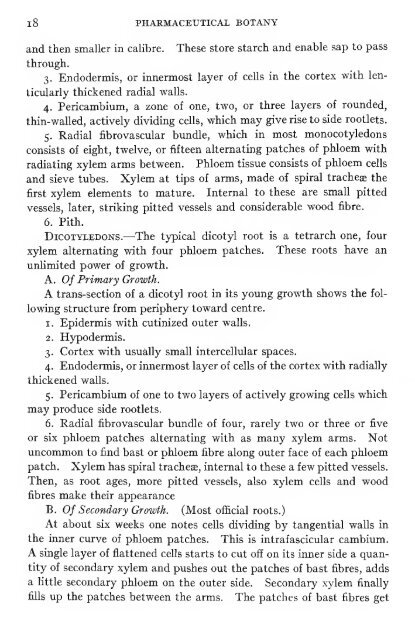Pharmaceutical botany - Lighthouse Survival Blog
Pharmaceutical botany - Lighthouse Survival Blog
Pharmaceutical botany - Lighthouse Survival Blog
Create successful ePaper yourself
Turn your PDF publications into a flip-book with our unique Google optimized e-Paper software.
1<br />
PHARMACEUTICAL BOTANY<br />
and then smaller in calibre. These store starch and enable sap to pass<br />
through.<br />
3. Endodermis, or innermost layer of cells in the cortex with len-<br />
ticularly thickened radial walls.<br />
4. Pericambium, a zone of one, two, or three layers of rounded,<br />
thin-walled, actively dividing cells, which may give rise to side rootlets.<br />
5. Radial fibrovascular bundle, which in most monocotyledons<br />
consists of eight, twelve, or fifteen alternating patches of phloem with<br />
radiating xylem arms between. Phloem tissue consists of phloem cells<br />
and sieve tubes. Xylem at tips of arms, made of spiral tracheae the<br />
first xylem elements to mature. Internal to these are small pitted<br />
vessels, later, striking pitted vessels and considerable wood fibre.<br />
6. Pith.<br />
Dicotyledons.— ^The typical dicotyl root is a tetrarch one, four<br />
xylem alternating with four phloem patches. These roots have an<br />
unlimited power of growth.<br />
A. Of Primary Growth.<br />
A trans-section of a dicotyl root in its young growth shows the fol-<br />
lowing structure from periphery toward centre.<br />
1. Epidermis with cutinized outer walls.<br />
2. Hypodermis.<br />
3. Cortex with usually small intercellular spaces.<br />
4. Endodermis, or innermost layer of cells of the cortex with radially<br />
thickened walls.<br />
5. Pericambium of one to two layers of actively growing cells which<br />
may produce side rootlets.<br />
6. Radial fibrovascular bundle of four, rarely two or three or five<br />
or six phloem patches alternating with as many xylem arms. Not<br />
uncommon to find bast or phloem fibre along outer face of each phloem<br />
patch. Xylem has spiral tracheae, internal to these a few pitted vessels.<br />
Then, as root ages, more pitted vessels, also xylem cells and wood<br />
fibres make their appearance<br />
B. Of Secondary Growth. (Most ofiicial roots.)<br />
At about six weeks one notes cells dividing by tangential walls in<br />
the inner curve of phloem patches. This is intrafascicular cambium.<br />
A single layer of flattened cells starts to cut off on its inner side a quan-<br />
tity of secondary xylem and pushes out the patches of bast fibres, adds<br />
a little secondary phloem on the outer side. Secondary xylem finally<br />
fills up the patches between the arms. The patches of bast fibres get
















